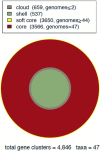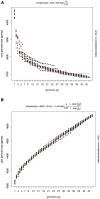Pan-genome association study of Mycobacterium tuberculosis lineage-4 revealed specific genes related to the high and low prevalence of the disease in patients from the North-Eastern area of Medellín, Colombia
- PMID: 36687645
- PMCID: PMC9846648
- DOI: 10.3389/fmicb.2022.1076797
Pan-genome association study of Mycobacterium tuberculosis lineage-4 revealed specific genes related to the high and low prevalence of the disease in patients from the North-Eastern area of Medellín, Colombia
Abstract
Mycobacterium tuberculosis (Mtb) lineage 4 is responsible for the highest burden of tuberculosis (TB) worldwide. This lineage has been the most prevalent lineage in Colombia, especially in the North-Eastern (NE) area of Medellin, where it has been shown to have a high prevalence of LAM9 SIT42 and Haarlem1 SIT62 sublineages. There is evidence that regardless of environmental factors and host genetics, differences among sublineages of Mtb strains play an important role in the course of infection and disease. Nevertheless, the genetic basis of the success of a sublineage in a specific geographic area remains uncertain. We used a pan-genome-wide association study (pan-GWAS) of 47 Mtb strains isolated from NE Medellin between 2005 and 2008 to identify the genes responsible for the phenotypic differences among high and low prevalence sublineages. Our results allowed the identification of 12 variants in 11 genes, of which 4 genes showed the strongest association to low prevalence (mmpL12, PPE29, Rv1419, and Rv1762c). The first three have been described as necessary for invasion and intracellular survival. Polymorphisms identified in low prevalence isolates may suggest related to a fitness cost of Mtb, which might reflect a decrease in their capacity to be transmitted or to cause an active infection. These results contribute to understanding the success of some sublineages of lineage-4 in a specific geographical area.
Keywords: M. tuberculosis; pan-GWAS; pan-genome; prevalence; sublineage; transmission; variant.
Copyright © 2023 Hurtado-Páez, Álvarez Zuluaga, Arango Isaza, Contreras-Moreira, Rouzaud and Robledo.
Conflict of interest statement
The authors declare that the research was conducted in the absence of any commercial or financial relationships that could be construed as a potential conflict of interest.
Figures








Similar articles
-
Pangenome and genomic signatures linked to the dominance of the lineage-4 of Mycobacterium tuberculosis isolated from extrapulmonary tuberculosis patients in western Ethiopia.PLoS One. 2024 Jul 25;19(7):e0304060. doi: 10.1371/journal.pone.0304060. eCollection 2024. PLoS One. 2024. PMID: 39052555 Free PMC article.
-
[Population structure analysis of Mycobacterium tuberculosis Beijing family in Japan].Kekkaku. 2009 Dec;84(12):755-9. Kekkaku. 2009. PMID: 20077859 Japanese.
-
Population structure among mycobacterium tuberculosis isolates from pulmonary tuberculosis patients in Colombia.PLoS One. 2014 Apr 18;9(4):e93848. doi: 10.1371/journal.pone.0093848. eCollection 2014. PLoS One. 2014. PMID: 24747767 Free PMC article.
-
There is no correlation between sublineages and drug resistance of Mycobacterium tuberculosis Beijing/W lineage clinical isolates in Xinjiang, China.Epidemiol Infect. 2015 Jan;143(1):141-9. doi: 10.1017/S0950268814000582. Epub 2014 Mar 25. Epidemiol Infect. 2015. PMID: 24667051 Free PMC article.
-
The Interplay of Human and Mycobacterium Tuberculosis Genomic Variability.Front Genet. 2019 Sep 18;10:865. doi: 10.3389/fgene.2019.00865. eCollection 2019. Front Genet. 2019. PMID: 31620169 Free PMC article. Review.
Cited by
-
Interred mechanisms of resistance and host immune evasion revealed through network-connectivity analysis of M. tuberculosis complex graph pangenome.mSystems. 2025 Apr 22;10(4):e0049924. doi: 10.1128/msystems.00499-24. Epub 2025 Mar 6. mSystems. 2025. PMID: 40261029 Free PMC article.
-
Pangenome and genomic signatures linked to the dominance of the lineage-4 of Mycobacterium tuberculosis isolated from extrapulmonary tuberculosis patients in western Ethiopia.PLoS One. 2024 Jul 25;19(7):e0304060. doi: 10.1371/journal.pone.0304060. eCollection 2024. PLoS One. 2024. PMID: 39052555 Free PMC article.
-
Bacterial genome-wide association studies: exploring the genetic variation underlying bacterial phenotypes.Appl Environ Microbiol. 2025 Jun 18;91(6):e0251224. doi: 10.1128/aem.02512-24. Epub 2025 May 16. Appl Environ Microbiol. 2025. PMID: 40377303 Free PMC article. Review.
-
Pangenome Reconstruction of Mycobacterium tuberculosis as a Guide to Reveal Genomic Features Associated with Strain Clinical Phenotype.Microorganisms. 2023 Jun 4;11(6):1495. doi: 10.3390/microorganisms11061495. Microorganisms. 2023. PMID: 37374997 Free PMC article.
-
High Prevalence of atpE Mutations in Bedaquiline-Resistant Mycobacterium tuberculosis Isolates, Russia.Emerg Infect Dis. 2025 Mar;31(3):525-536. doi: 10.3201/eid3103.241488. Emerg Infect Dis. 2025. PMID: 40023803 Free PMC article.
References
-
- Almanza R., Montes F., González D., Zapata S. (2019). Situación de la tuberculosis en medellín 2018. Secretaría de Salud de Medellín: Boletin epidemiológico.
-
- Andrews S. (2010). FastQC a quality control tool for high throughput sequence data. Available online at: http://www.bioinformatics.babraham.ac.uk/projects/fastqc/ (accessed July, 2017).
LinkOut - more resources
Full Text Sources

